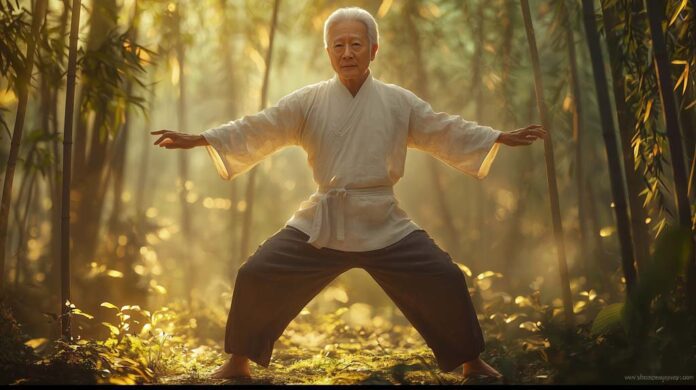Baduanjin Qigong, an ancient Chinese exercise system, is a fascinating method for enhancing physical and mental well-being.
I stumbled upon this intriguing practice while researching my blog post on Exercise for Mental Health: Effective Management Tools. The more I explored, the more I realised its potential significance for BeSund readers.
This gentle yet powerful exercise, often called the ‘Eight Pieces of Brocade’, has been practised in China for centuries. Its enduring popularity stems from its ability to promote health, increase longevity, and foster a sense of inner calm. The exercises, rooted in Traditional Chinese Medicine principles, focus on harmonising the body’s energy or ‘Qi’ (pronounced “chee”).
In China, many people gather in parks and public spaces each morning to practise Baduanjin Qigong. This communal activity promotes physical health and also strengthens social bonds. Seeing elderly practitioners moving with grace and vitality is a testament to the exercise’s effectiveness in promoting healthy ageing.
The growing scientific evidence supporting Baduanjin Qigong’s benefits is fascinating. Studies have shown improved cardiovascular health, balance, and flexibility among practitioners. Moreover, researchers have observed positive effects on mental health, including reduced stress and anxiety levels.
It was natural that I would be drawn to Baduanjin Qigong, as it follows my earlier investigation into Radio Taiso, the Japanese morning exercise routine. Both practices focus on gentle, accessible movements that can be performed by people of all ages and fitness levels. They represent a holistic approach to health that goes beyond physical fitness gains.
In this post, I will present the rich history of Qigong, examine the specific origins of Baduanjin, and detail its eight core movements. I will then turn to the West, look into the scientific research supporting its health benefits, and provide practical advice for incorporating this ancient practice into modern life.
The History and Principles of Qigong
Qigong’s roots stretch back thousands of years in Chinese culture. This ancient practice, which includes forms like Baduanjin Qigong, focuses on cultivating and balancing ‘Qi’, the life force energy believed to flow through all living things. ‘Qigong’ combines ‘Qi’ (energy) and ‘Gong’ (cultivation or mastery).
Early forms of Qigong emerged during the Warring States period (475-221 BCE). These practices were closely linked to Taoist philosophy and Chinese medicine. Practitioners sought to harmonise body, mind, and spirit through specific movements, breathing techniques, and meditation.
Fundamental principles of Qigong include:
- Regulating the body: Adopting specific postures and movements
- Regulating the breath: Controlling breathing patterns
- Regulating the mind: Focusing attention and cultivating awareness
- Regulating Qi: Directing the flow of energy within the body
Over time, Qigong evolved into various schools and styles. Some focused on health maintenance, others on martial arts applications, and others on spiritual development. Despite these differences, all forms of Qigong share the fundamental goal of balancing and cultivating Qi.
During the Tang Dynasty (618-907 CE), Qigong practices gained popularity among scholars and officials. They viewed these exercises as enhancing longevity and maintaining mental clarity. This period saw the development of many Qigong routines still practised today, including early versions of Baduanjin Qigong.
In the modern era, Qigong has gained recognition beyond China’s borders. Its potential health benefits have attracted interest from medical researchers and health enthusiasts worldwide. Today, millions of people practise Qigong as part of their daily wellness routines.
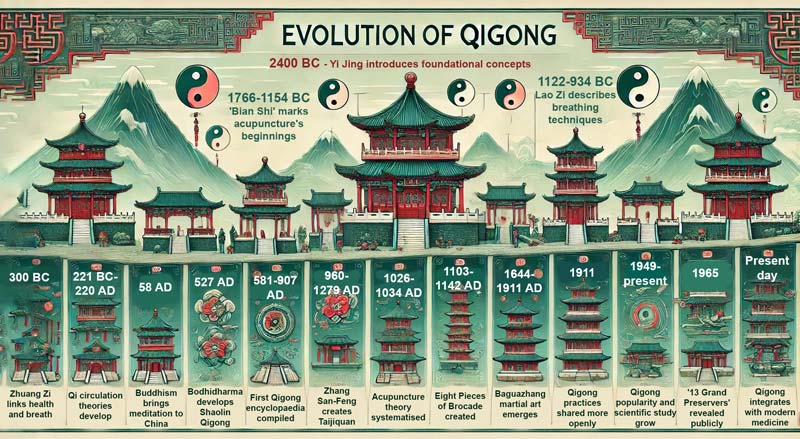
Baduanjin Qigong: Origins and Popularity in the West
The more I researched the world of Qigong, the more I found myself drawn to Baduanjin Qigong. This ancient practice, often translated as ‘Eight Pieces of Brocade,’ has a rich history of over 800 years.
Baduanjin Qigong’s origins can be traced back to the Song Dynasty (960-1279 CE). Legend attributes its creation to the renowned general Yue Fei, who reportedly developed these exercises to maintain his soldiers’ health and combat readiness. However, some scholars suggest the practice evolved from earlier Taoist longevity exercises.
The name ‘Baduanjin’ offers intriguing insights into the practice:
- ‘Ba’ means eight, referring to the number of movements
- ‘Duan’ translates to section or piece
- ‘Jin’ implies brocade, a luxurious silk fabric
Together, these characters paint a picture of a precious, multifaceted practice. Each movement is considered a valuable piece of a larger, beautiful whole.
Over the centuries, Baduanjin Qigong has undergone various refinements. Different schools and masters have adapted the basic movements, leading to several variations. Despite these differences, the core principles and benefits remain consistent across all versions.
In recent decades, Baduanjin Qigong has gained significant popularity in the West. Its simplicity and accessibility have made it particularly appealing to those new to Qigong practices. Moreover, the growing interest in holistic health approaches has fuelled its spread beyond China’s borders.
Western practitioners often appreciate Baduanjin Qigong for its:
- Simplicity: The movements are easy to learn and remember
- Flexibility: It can be practised in limited space and requires no special equipment
- Adaptability: The exercises can be modified to suit different fitness levels
- Time efficiency: An entire session can be completed in as little as 10-15 minutes
Interestingly, Baduanjin Qigong has also caught the attention of Western researchers. Scientific studies have begun to explore its potential health benefits, adding empirical support to centuries of anecdotal evidence.
As someone who loves peace of mind and neuroplasticity and is new to this practice, I find the blend of ancient wisdom and modern scientific interest particularly fascinating. It’s a testament to these seemingly simple exercises’ enduring value and benefits.
The Eight Movements of Baduanjin Qigong
Baduanjin Qigong, often called the Eight Pieces of Brocade, is a treasure trove of ancient Chinese wisdom. As I researched the practice, I was captivated by these eight distinct movements’ profound simplicity and potential benefits.
Each exercise in Baduanjin Qigong is carefully designed to target specific aspects of health and well-being. Together, they form a comprehensive system that promotes overall health by addressing different body systems and energy meridians.
The beauty of this practice lies in its versatility – it can be performed standing or sitting, making it accessible to people of various fitness levels and physical abilities.
What struck me most was how these seemingly simple movements encapsulate complex principles of Traditional Chinese Medicine. Each exercise blends physical movement, breath control, and mental focus, creating a holistic mind-body practice. The movements work harmoniously to promote Qi flow, enhance flexibility, strengthen muscles, and calm the mind.
Before beginning the Baduanjin Qigong sequence, it’s crucial to adopt the correct starting position:
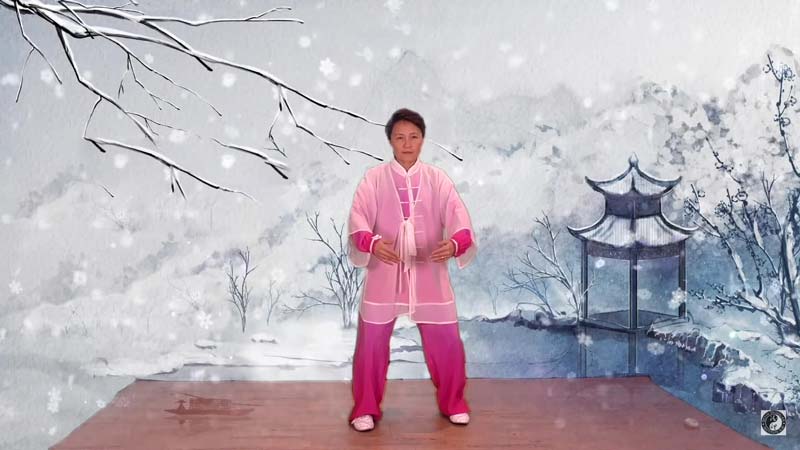
Starting Position
Steps:
- Stand with feet shoulder-width apart
- Bend knees slightly
- Hold palms in front of your abdomen
- Breathe naturally
- Relax your body
- Focus your mind on the Dan Tian (lower abdomen)
Now, let’s explore each of the eight movements:
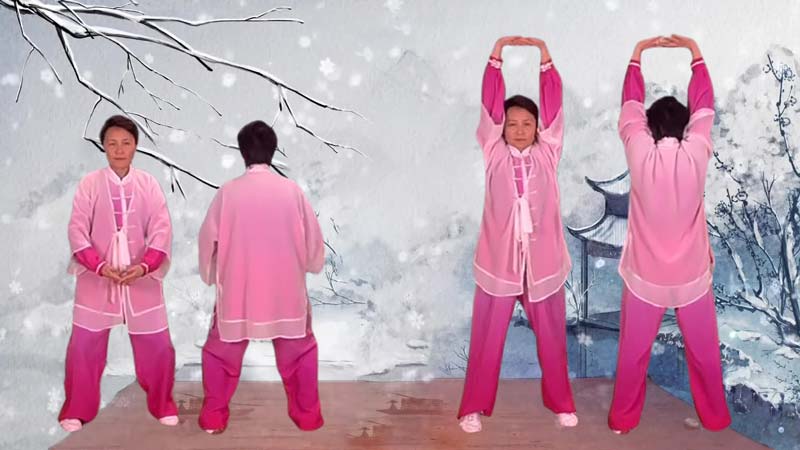
- Two Hands Hold up the Heavens
This opening exercise aims to regulate the ‘Triple Burner’ and stretch the body’s core. It’s believed to smooth Qi flow throughout the body, promoting overall balance and vitality.
Steps:
- Stand with feet shoulder-width apart
- Interlace fingers and raise hands above head, palms facing up
- Rise onto toes while stretching arms upward
- Lower heels and arms, returning to the starting position
- Repeat 8 times
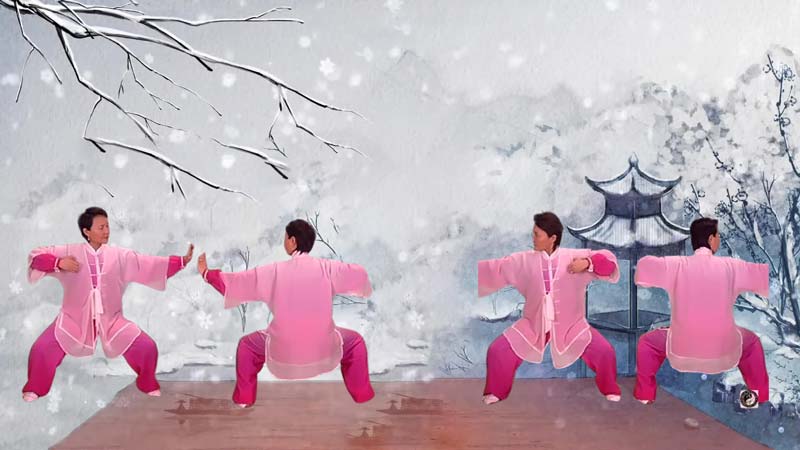
- Drawing the Bow to Shoot the Hawk
This movement focuses on strengthening the kidneys and waist. It’s particularly beneficial for those who spend long hours sitting, as it helps alleviate lower back tension.
Steps:
- Adopt a horse stance, feet wider than shoulders
- Extend left arm forward, right arm back as if drawing a bow
- Turn your head to look at the extended left-hand
- Switch sides, repeating the movement
- Perform 8 times on each side

- Separate Heaven and Earth
This exercise targets the spleen and stomach to harmonise the digestive system. It’s beneficial for those with weak digestive function or frequent fatigue.
Steps:
- Stand with feet shoulder-width apart
- Raise one hand above head, palm up, while lowering the other hand, palm down
- Push up with top hand, press down with bottom hand
- Switch hands and repeat
- Perform 8 times on each side
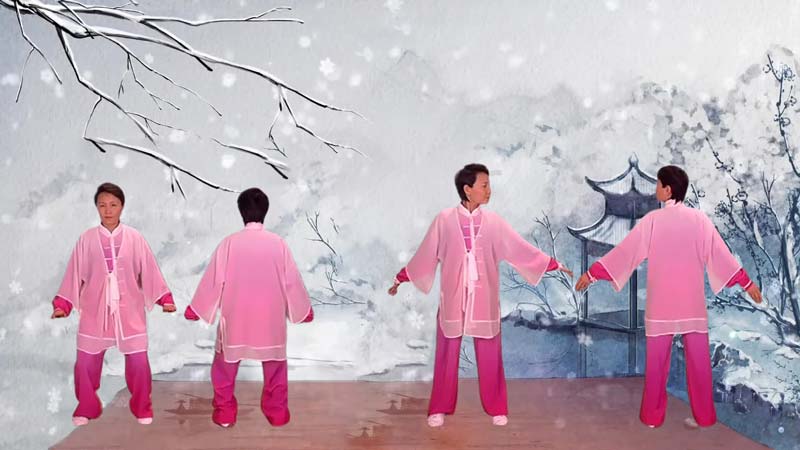
- Wise Owl Gazes Backwards
This movement focuses on the neck and shoulders, areas often tense in our modern, desk-bound society. Regular practice may help alleviate neck stiffness and headaches.
Steps:
- Stand with feet shoulder-width apart
- Place hands on hips
- Turn your head to look over the left shoulder
- Return to the centre, then turn to the right
- Repeat 8 times on each side
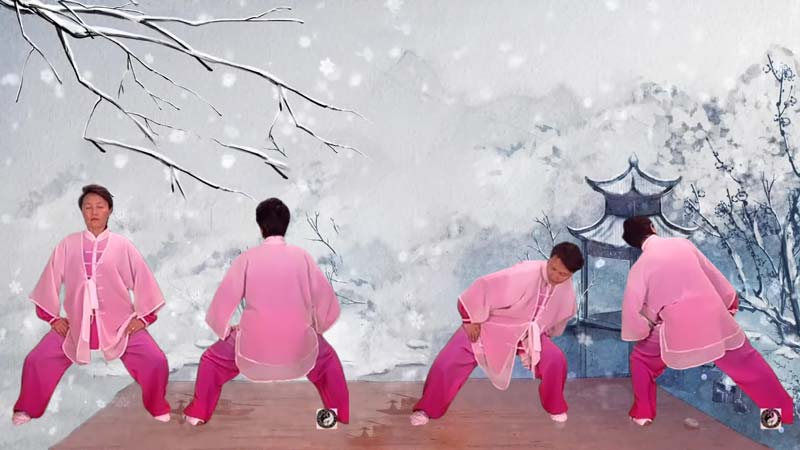
- Sway the Head and Shake the Tail
This exercise is designed to calm the heart and mind. It’s particularly beneficial for those dealing with stress or anxiety, promoting a sense of inner peace.
Steps:
- Adopt a wide stance
- Bend forward, hands on knees
- Circle the upper body to the left, then the right
- Keep lower body stable
- Perform 8 circles in each direction
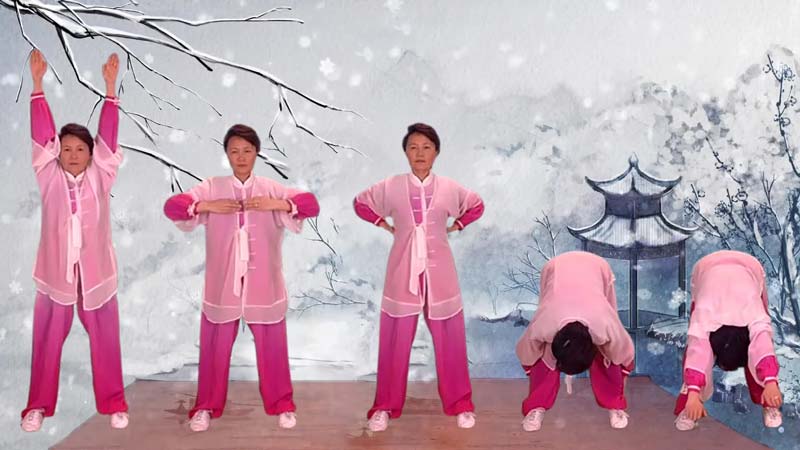
- Two Hands Hold the Feet to Strengthen the Kidneys and Waist
This movement targets the back muscles and kidneys. It improves flexibility and may help those with mild lower back discomfort.
Steps:
- Stand with feet shoulder-width apart
- Bend forward from the waist
- Grasp ankles or toes with hands
- Hold for a few seconds, then slowly rise
- Repeat 8 times
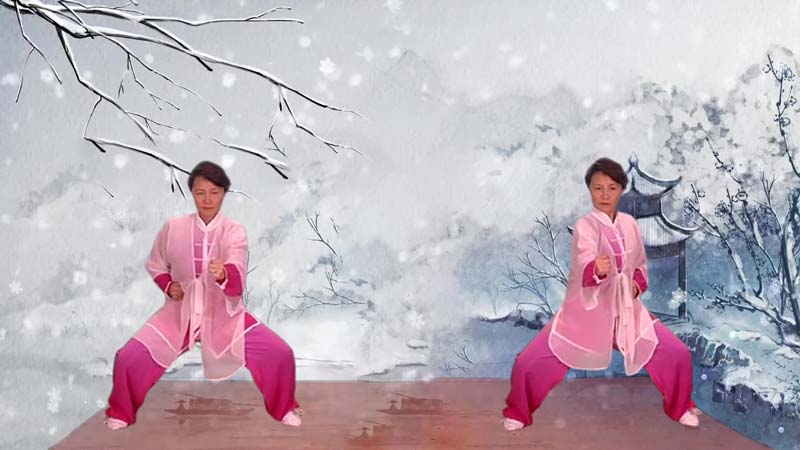
- Clench the Fists and Glare Fiercely
This dynamic exercise aims to stimulate liver function and increase overall Qi. It’s particularly invigorating and can help shake off morning grogginess.
Steps:
- Adopt a horse stance
- Clench fists at waist level
- Extend one fist forward while pulling the other back
- Alternate sides rapidly
- Repeat for 8 breath cycles

- Bouncing on the Toes
The final movement in Baduanjin Qigong is believed to smooth out the Qi flow and harmonise organ functions. It’s a gentle way to conclude the practice, leaving you feeling balanced and energised.
Steps:
- Stand with feet shoulder-width apart
- Rise onto toes and lower heels rhythmically
- Keep the body relaxed, allowing it to bounce gently
- Continue for 8 breath cycles
After completing the eight movements, it’s essential to finish with the closing position:
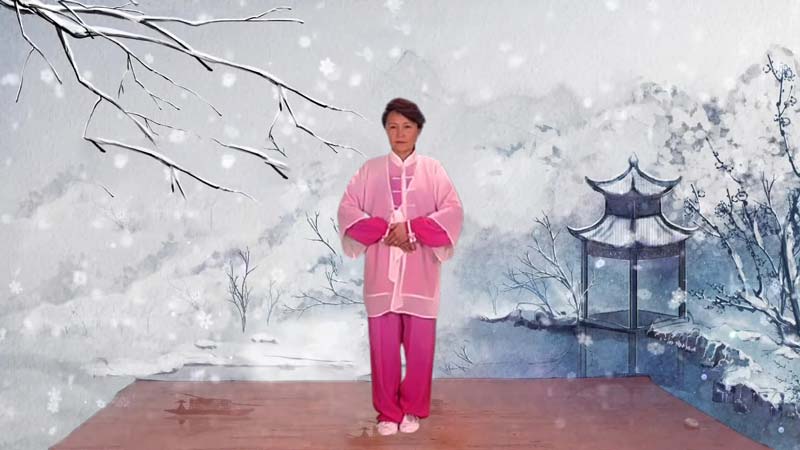
Closing Position
Steps:
- Hold palms in front of the abdomen (left hand inside for men, right hand inside for women)
- Adopt a serene body posture
- Relax your whole body
- Breathe evenly
- Guide your Qi down to the Dan Tian
Regular practice of Baduanjin Qigong can yield significant health benefits, some of which we will discuss below. The idea is to perform each movement mindfully, coordinating breath with motion and maintaining proper form throughout the practice.
Scientific Evidence on Baduanjin Qigong Benefits
Being fact-based, the more I researched Baduanjin Qigong, the more impressed I was by the growing body of scientific evidence supporting its benefits.
This ancient practice, rooted in Traditional Chinese Medicine, has caught the attention of researchers worldwide. Studies have explored its effects on various aspects of health, from physical fitness to mental well-being.
Baduanjin Qigong’s gentle, flowing movements and meditative focus make it accessible to people of all ages and fitness levels. This inclusivity has allowed researchers to study its effects across diverse populations, providing a comprehensive picture of its potential benefits.
What struck me most was the holistic nature of these benefits. Unlike many modern exercises targeting specific fitness aspects, Baduanjin Qigong offers a more balanced approach to health improvement. From cardiovascular health to cognitive function, the research paints a picture of a practice that nurtures the body and mind in tandem.
Below are some of the areas where Baduanjin Qigong has shown promising results.
Improved Physical Health and Fitness
With its graceful movements and mindful breathing, Baduanjin Qigong offers a range of physical health benefits. This low-impact exercise has remarkably affected cardiovascular health, muscular strength, and overall physical fitness.
One of Baduanjin Qigong’s most significant benefits is its positive impact on cardiovascular health. Regular practice can improve blood pressure and heart rate.
A comprehensive review found that Baduanjin exercise can strengthen blood circulation in internal organs, promote smooth Qi flow, and enhance cardiovascular function.
Baduanjin Qigong also improves muscle strength and flexibility. The practice involves various movements that engage different muscle groups, particularly in the upper and lower limbs.
For instance, the “drawing the bow on both sides” pose engages the hamstring muscles while stretching the quadriceps, while “bouncing on the toes” simultaneously strengthens both the anterior and posterior lower limb muscles.
Interestingly, Baduanjin Qigong has shown promise in improving balance and postural stability, particularly in older adults. This is crucial for preventing falls and maintaining independence in later life. A systematic review and meta-analysis found that Baduanjin’s practice significantly improved balance, flexibility, and overall physical function.
The beauty of Baduanjin Qigong lies in its accessibility. Unlike high-intensity workouts, this gentle practice can be adapted to suit various fitness levels. It is an excellent option for those looking to improve their physical health without putting undue stress on their bodies.
Enhanced Mental Health and Stress Reduction
Baduanjin Qigong offers a holistic approach to mental well-being, combining physical movement with mindful awareness. Here’s how this ancient practice contributes to enhanced mental health and stress reduction:
- Anxiety and Depression: Studies show Baduanjin practice can significantly reduce symptoms of anxiety and depression.
- Stress Management: Baduanjin’s slow, deliberate movements and focused breathing help lower perceived stress levels.
- Emotional Regulation: Regular practice may improve overall mood and emotional well-being.
- Sleep Quality: Baduanjin has been associated with improved sleep quality, which is crucial for mental health.
Critical aspects of Baduanjin that contribute to these benefits:
- Mind-Body Integration: Coordinating movement with breath fosters a sense of calm and present-moment awareness.
- Gentle Physical Activity: The low-impact nature of Baduanjin provides the mental health benefits of exercise without undue physical stress.
- Meditative Focus: Concentrating on the movements can help quiet a busy mind, reducing rumination and worry.
- Community Practice: Often performed in groups, Baduanjin can provide social support, further enhancing its mental health benefits.
While more research is needed to fully understand the mechanisms behind Baduanjin’s mental health benefits, its accessibility and potential for stress reduction make it a valuable tool for promoting psychological well-being.
Baduanjin Qigong for Pain Management
Baduanjin Qigong offers a gentle yet practical approach to pain management. This ancient practice has shown promise in alleviating discomfort associated with various conditions:
Chronic Musculoskeletal Pain:
- A systematic review found Baduanjin effective in alleviating musculoskeletal pain in individuals with chronic conditions.
- The gentle, flowing movements help improve flexibility and reduce stiffness.
Fibromyalgia:
- A randomisedrandomised controlled trial reported significant pain reduction in fibromyalgia (a disorder causing widespread pain, fatigue, and issues with sleep, memory, and mood) patients practising Baduanjin.
- 77% of participants achieved a 30% or more significant reduction in pain intensity.
Knee Osteoarthritis:
- Studies suggest Baduanjin may help reduce pain and improve function in individuals with knee osteoarthritis.
- The low-impact nature of the exercise makes it suitable for those with joint issues.
Neck Pain:
Potential mechanisms of pain relief:
- Improved muscle strength and flexibility
- Enhanced body awareness and posture
- Stress reduction, which can indirectly affect pain perception
- Potential modulation of inflammatory markers
Cognitive Function and Neuroplasticity
The impact of Baduanjin Qigong on cognitive function and neuroplasticity has become a fascinating area of research in recent years.
Research suggests regular Baduanjin practice may enhance cognitive function, particularly in older adults. Studies have shown improvements in memory, attention, and executive function following consistent engagement with this gentle exercise. These findings are especially promising given our ageing population’s growing concern about age-related cognitive decline.
One of the most exciting aspects of Baduanjin Qigong is its potential effect on brain structure and function. Neuroimaging studies have revealed intriguing changes in practitioners’ brains, including increased grey matter volume in areas associated with cognitive processes. These structural changes contribute to the observed improvements in mental performance.
Baduanjin Qigong’s mind-body nature likely plays a crucial role in its cognitive benefits. The practice combines physical movement with mental focus and controlled breathing, potentially enhancing brain plasticity and cognitive reserve.
This multifaceted approach may explain why some research suggests that Baduanjin could be more effective than simple aerobic exercises like jogging to maintain cognitive function in older adults.
Sleep Quality and Insomnia Relief with Baduanjin Qigong
Baduanjin Qigong’s potential to improve sleep quality and alleviate insomnia has garnered significant attention. Here’s what research tells us about its effects on sleep:
Overall Sleep Quality:
- Studies show Baduanjin practice can lead to notable improvements in sleep quality.
- Practitioners often report better sleep duration, efficiency, and reduced sleep disturbances.
Insomnia Relief:
- Research indicates Baduanjin may help alleviate symptoms of insomnia.
- The practice could be particularly beneficial for older adults with sleep disturbances.
Physiological Effects:
- Some studies suggest Baduanjin might influence sleep-related hormones like melatonin.
- The practice may help regulate the autonomic nervous system, promoting better sleep.
Chronic Conditions and Sleep:
- Baduanjin has shown promise in improving sleep for individuals with chronic diseases.
Cancer patients undergoing chemotherapy have reported better sleep quality with regular practice.

Integrating Baduanjin Qigong into Daily Life
With its rich history spanning over 800 years, Baduanjin Qigong offers a holistic approach to health that’s both accessible and effective. As I explored ways to incorporate this ancient practice into modern routines, I was struck by its adaptability and potential benefits for people of all ages and fitness levels.
The beauty of Baduanjin lies in its simplicity. Comprising eight movements, each taking 2-3 minutes, the entire set can be completed in roughly 20 minutes. This concise format makes it ideal for even the busiest schedules.
The practice emphasises gentle yet firm movements, guided by a calm mind and natural breathing, fostering a harmonious connection between body and spirit.
For those new to Baduanjin Qigong, here are some practical tips for getting started:
- Start slowly with shorter sessions, gradually building up to the 20-minute routine.
- Seek guidance: Attend face-to-face classes with a trained instructor for proper form and technique.
- Use resources: Explore printed materials or online guides explaining the theory and principles of Baduanjin.
- Practice regularly: Aim for at least three 60-minute weekly or daily 15-minute practices.
- Choose your setting: Baduanjin can be practised indoors or outdoors, alone or in groups.
- Monitor intensity: Keep the exercise gentle; your maximum heart rate should reach 54%.
- Be patient: Consistent practice over 8 weeks or more is imperative to experiencing noticeable benefits.
One of the most appealing aspects of Baduanjin Qigong is its flexibility. Whether you’re an office worker looking to reduce stress, an older adult aiming to improve balance, or someone managing a chronic condition, Baduanjin can suit your needs.
Its low-impact nature makes it particularly suitable for those with physical limitations while offering substantial health benefits.
Integrating Baduanjin into your existing fitness routine can enhance overall well-being. Consider using it as a warm-up before more intense exercises or as a cool-down to promote relaxation.
Short Baduanjin sessions throughout the day can help maintain energy levels and improve focus for those with sedentary jobs.
Remember, your practice with Baduanjin Qigong is personal. Listen to your body, adjust the practice as needed, and enjoy connecting with this ancient art.
With time and consistency, Baduanjin becomes more than an exercise; it becomes a valued part of your daily life (as I have seen with yoga for the past four years), contributing to improved physical health, mental clarity, and overall vitality.
Finding a practice that balances physical activity with mental calm in our fast-paced world can be transformative. Baduanjin Qigong offers this balance, providing a moment of mindful movement in our busy days!
Sources
- An BC, Wang Y, Jiang X, et al. Effects of Baduanjin exercise on knee osteoarthritis: A one-year study. Chin J Integr Med. 2013;19:143–148.
- Antonishen K. Exercise mode heterogeneity among reported studies of the qigong practice Baduanjin. J Bodyw Mov Ther. 2015;19:278–283.
- Chen MC, Liu HE, Huang HY, Chiou AF. The effect of a simple traditional exercise programme (Baduanjin exercise) on sleep quality of older adults: a randomisedrandomised controlled trial. Int J Nurs Stud. 2012 Mar;49(3):265–73.
- Fan B, Song W, Zhang J, et al. The efficacy of mind‐body (Baduanjin) exercise on self‐reported sleep quality and quality of life in elderly subjects with sleep disturbances: A randomisedrandomised controlled trial. Sleep and Breathing. 2020;24(2):695–
- Jiao J, Russell IJ, Wang W, et al. Ba-Duan-Jin alleviates pain and fibromyalgia-related symptoms in patients with fibromyalgia: results of a randomisedrandomised controlled trial. Clin Exp Rheumatol. 2019;37(6):953–962.
- Jwing-Ming Yang. (1997). Eight Simple Qigong Exercises: The Eight Pieces of Brocade. YMAA Publication Center; 2nd edition.
- Kong L, Ren J, Fang S, et al. Traditional Chinese exercises on pain and disability in middle-aged and elderly patients with neck pain: a systematic review and meta-analysis of randomisedrandomised controlled trials. Front Aging Neurosci. 2022;14:912–45.
- Li M, Fang Q, Li J, et al. The effect of Chinese traditional exercise-Baduanjin on physical and psychological well-being of college students: a randomised controlled trial. PLoS ONE. 2015;10(7):e0130544.
- Lu Y, Qu HQ, Chen FY, et al. Effect of Baduanjin Qigong Exercise on Cancer-Related Fatigue in Patients with Colorectal Cancer Undergoing Chemotherapy: A Randomized Controlled Trial. Oncol Res Treat. 2019;42(9):431-439.
- Mei L, Chen Q, Ge L, et al. Systematic review of Chinese traditional exercise Baduanjin modulating the blood lipid metabolism. Evid Based Complement Alternat Med. 2012;2012:282131.
- Stephen Comee. (2011). Beginning Qigong: Chinese Secrets for Health and Longevity. Tuttle Publishing.
- Tao J, Liu J, Chen X, et al. Mind-body exercise improves cognitive function and modulates the function and structure of the hippocampus and anterior cingulate cortex in patients with mild cognitive impairment. NeuroImage: Clinical. 2019;23.
- Tao J, Liu J, Egorova N, et al. Increased Hippocampus-Medial Prefrontal Cortex Resting-State Functional Connectivity and Memory Function after Tai Chi Chuan Practice in Elder Adults. Front Aging Neurosci. 2016;8:25.
- Wang F, Zhang X, Tong X, Zhang M, Xing F, Yang K, Jiao N, Duan Z. The effects on pain, physical function, and quality of life of quadriceps strengthening exercises combined with Baduanjin qigong in older adults with knee osteoarthritis: a quasi-experimental study. BMC Musculoskelet Disord. 2021 Mar 29;22.
- Zhang Y, Jiang X. The effect of Baduanjin exercise on the physical and mental health of college students: A randomisedrandomised controlled trial. Medicine (Baltimore). 2023 Aug 25;102(34):e34897.
- Zou L, Yeung A, Quan X, et al. A systematic review and meta-analysis of mindfulness-based (Baduanjin) exercise for alleviating musculoskeletal pain and improving sleep quality in people with chronic diseases. Int J Environ Res Public Health. 2018;15(2):206.
- Zou L, Yeung A, Quan X, et al. Mindfulness-based Baduanjin exercise for depression and anxiety in people with physical or mental illnesses: a systematic review and meta-analysis. Int J Environ Res Public Health. 2018;15(2):321.
- Zou L, SasaKi JE, Wang H, Xiao Z, Fang Q, Zhang M. A Systematic Review and Meta-Analysis Baduanjin Qigong for Health Benefits: Randomized Controlled Trials. Evid Based Complement Alternat Med. 2017;2017:4548706.


